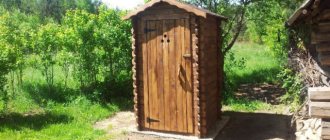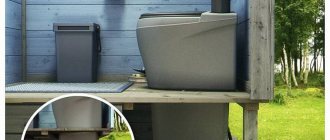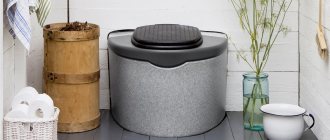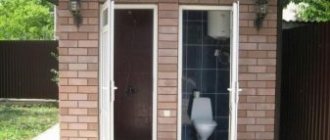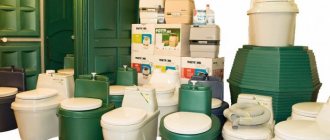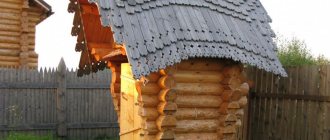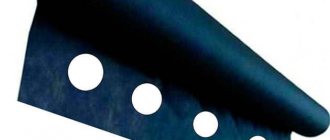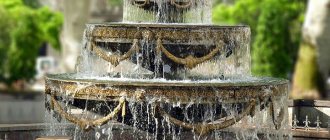- December 8, 2019
- Country house
- Olga Pechenaya
Where there are people, the toilet becomes a necessity. Spending time at your dacha will be much more enjoyable if all the conditions are created for this. You can, of course, not notice this problem, using the nearest bushes and sheds, but still sensible summer residents are trying to create comfort for themselves. Many people ask the question: “Which toilet should I choose for my dacha?” After all, I really want to dwell on the most practical and inexpensive way to solve the problem of waste disposal at my summer cottage.
Some don’t even try to stand out in any way and use a simple outdoor toilet for their dacha. Others take a creative approach to this issue and create a truly comfortable home bathroom.
Which toilet to choose for your dacha, where it is best to place it - these are the main questions that we will try to answer today.
First you need to choose the type of toilet. It can be outdoors or indoors, have a cesspool or do without it. This article will help you not to get confused and make a mistake with your choice.
Toilet location
In total, there are two options for the location of the toilet in the country. The first is the arrangement of a bathroom inside the country house. The advantages of this location are undeniable. Disadvantages - you need to allocate a separate room, plus there will be high costs for ventilation and sewerage. The second option, the most suitable for a dacha, is an outdoor toilet. Plus - inexpensive, minus - far from home.
As for the type of toilet. Here, too, two options can be distinguished - with and without a cesspool. A toilet with a cesspool can be located either inside the home or as a separate room. In this case, a cesspool or septic tank is required. Plus - infrequent emptying of the pit. The downside is that pumping can be expensive due to the remoteness of the site.
A toilet without a cesspool can also be located inside or outside the living space. Pros: easy installation, mobility. Cons: small tank capacity, costs for consumables.
Other restrictions on the location of the toilet primarily concern options with a cesspool. The most important criterion here is the groundwater level. If this mark is higher than 3.5 m, you should choose the option without a cesspool. Otherwise, there is a risk of flooding the site with waste products.
There are a number of other restrictions on the location of the cesspool from certain objects:
- from a residential building - 3 meters;
- from other buildings - 1 meter;
- from buildings for keeping livestock and birds - 4 meters;
- from bushes - 1 meter;
- from medium trees - 2 meters;
- from tall trees - 3 meters;
- from water sources - at least 25 meters;
- from the bathhouse, shower - at least 8 meters;
- from the fence - at least 1 meter.
It is also worth remembering that it is necessary to provide access to the cesspool to special equipment for pumping out waste. The hose length is usually about 7 meters.
What is good about a galvanized steel toilet?
One of the most budget-friendly options is a toilet for a summer house made of galvanized steel.
Advantages of this material:
- flexibility;
- ease of installation;
- availability.
The steel toilet bowl is a cylinder of optimal height for use with allowances at the top and bottom. The low cost of manufacturing a galvanized toilet makes it especially attractive for rarely visited summer cottages.
A pipe with the required parameters is selected (height should be from 40 cm, cross-section within 30-35 cm). On the seam allowances, make small cuts at intervals of 5 cm and bend the ends around the circumference in the shape of a daisy.
The lower ends are secured to the floor with self-tapping screws, and a pre-prepared sheet of plywood is screwed to the upper ends. Its width should be at least 8 cm. The base is adjusted to the required dimensions, and a plastic toilet seat is secured on top using rivets. The structure is installed above the septic tank.
Installing a toilet made of steel sheets does not require special knowledge and skills. Inexpensive materials are used to install the structure
To give the outdoor toilet a finished look, a frame is installed around the toilet, which is covered with boards or sheets of plywood. Sometimes a door is made in the front wall, which creates a pantry for storing household chemicals.
A toilet made of galvanized steel is not particularly attractive, but in every household you can find the materials necessary for installing the structure.
Types of country toilets
To decide which toilet to choose in your dacha, you can use a table with their main types and all the advantages and disadvantages.
| Toilet type | pros | Minuses |
| Classic closet | Cheap, simple, infrequent cleaning, do-it-yourself, no plumbing required | Risk of groundwater contamination, cleanup costs |
| Backlash closet | The same as the classic one: easy access to the pit, no smell in the cabin itself, the ability to equip a toilet room in the home | Same as the classic one |
| Septic tank | Infrequent cleaning, does not pollute soil and groundwater, does not require running water, no odor | Expensive installation and maintenance |
| Powder closet | Does not require the construction of a cesspool, is cheap, does not require cleaning equipment, does not require running water | Constant removal of waste to the compost pit |
| Plastic booth | Mobile, durable, easy to care for | Needs pumping, costs for consumables |
| Bucket toilet | Can be located indoors, minimum cost | Odor, need to remove waste frequently |
| Peat dry closet | Easy to use, environmentally friendly, infrequent storage tank emptying | Stationary due to the need for a ventilation system |
| Dry toilet with chemical reagents | Lightweight, compact, sealed, hygienic | Costs for special liquid, drainage into central sewer required |
| Dry toilet with biological reagents | Lightweight, compact, sealed, hygienic | Expensive liquid |
| Electric dry closet | Easy to clean, hygienic, aesthetically pleasing | Stationary due to the need for ventilation, expensive, requires electricity |
| Full bathroom | Convenience, convenience and more convenience | The most expensive option, requires a separate room in the house, it is necessary to heat |
Next, we need to look at each type in more detail.
Regular classic closet
Even in the last century, the question of which toilet to choose for a summer house had a clear answer. The most popular among summer residents throughout the country were, undoubtedly, structures with cesspools. Today, many alternatives have appeared, but many dacha owners continue to use and build classic toilets on their plots.
Most often, the pit size is up to two cubic meters. The walls are laid out from available materials: brick, cinder block, etc. The bottom of the pit is arranged in two ways:
- Sealed. The bottom is filled with concrete. Due to the tightness of the container, groundwater is not contaminated. But such a pit will have to be cleaned more often.
- Drainage. The bottom is covered with gravel and sand. Drainage allows liquid to pass through, so it takes longer for the hole to fill. But there is a danger of groundwater contamination.
Powder closet
This is the simplest version of a country toilet. There is no need to dig a cesspool or strengthen its walls. It is enough to install a small booth made of any convenient material, install a toilet seat inside with an easily removable container. In the classic version, this is a plastic bucket. A reservoir with peat or sawdust is placed nearby. After using the toilet, waste products are covered with the contents of the tank. The filled container is removed and taken to the compost pit. A peat toilet for a summer house can be built at minimal cost, but it is better to immediately take care of good ventilation.
Plastic booth
A relatively simple solution to the waste disposal problem is a plastic toilet. For a dacha - quite a suitable option. It is durable, lightweight, resistant to external factors, and easy to keep clean.
Such bathrooms are arranged very simply: a cubicle with a door, a toilet seat installed inside, and under it a tank with a volume of 150 to 380 liters. Ventilation is required in such booths.
The main advantages of a plastic toilet for a summer residence are:
- ease and speed of installation;
- minimum effort to keep the toilet clean;
- resistance to external influences;
- Insulated cabins can be used at sub-zero temperatures.
But there are also disadvantages:
- the need to buy chemicals to break down waste;
- requires tank cleaning;
- simple cabins cannot be used in sub-zero temperatures.
Price
The price of a septic tank depends on the volume and equipment. Here are some examples:
- "Cumulative". Different models have a volume from 1100 to 10 thousand liters. No equipment is provided. Cost - from 17 thousand to 59 thousand rubles.
- "Tver". Cost: from 64 thousand to 89 thousand rubles (various equipment available).
- "Tank". Septic tank with a volume of 1 cubic meter. m costs 20 thousand rubles, volume 2 cubic meters. m - 36 thousand rubles. (without equipment).
Here are the prices for various dry toilets:
- Thetford Qube 345. Dutch chemical toilet with a storage capacity of 12 liters. Costs 6155 rubles.
- Ecomatic. Finnish-made peat dry closet with a storage capacity of 110 liters. Cost - 25.5 thousand rubles.
Separett Willa 9011 (Sweden) - an electric composting toilet with a 23-liter storage container - costs 34.8 thousand rubles.
Bucket toilet
This is a pretty good option if the issues with the sewage system at the dacha have not yet been resolved, but basic amenities are still needed. But even if there is an outdoor toilet at the dacha, it is somewhat remote from the living space, and visiting it at night is usually not a pleasure.
In such cases, a bucket toilet will be a practical, inexpensive and easy way to solve this problem. It is a rather primitive design: a bucket with a seat that closes with a lid, as well as a handle for easy transportation to the cesspool.
Dry toilet
Such a toilet is usually a small device. There are several types of such devices, but each of them contains two cameras - upper and lower. The upper one is actually used as a toilet, and the lower one is needed for recycling waste.
The dry closet is a universal solution. Firstly, it is compact, easy to assemble, mobile, and does not require additional communications. Secondly, such a toilet can be located inside the living space and outside in a separate building. You can also do without building a cesspool. Using biological fluids to break down waste, you can empty such a toilet in any area of the dacha.
Dry toilets come in different types:
- chemical;
- biological;
- peat;
- electric.
Chemical
This type of dry closet uses formaldehyde-based liquid. Discharge of such waste is possible only into the central sewer system, so this type of device is not very popular among summer residents.
Biological
This type is considered the most environmentally friendly. Liquid based on microorganisms is used to fill dry toilets. These devices are often chosen by summer residents, since recycled waste can be used as fertilizer and poured into a compost pit. The only drawback of such toilets is the high price of special fillers.
Peat
Such dry closets do not require any running water. In them, waste is filled with peat, sawdust and other similar components. Often the container for collecting waste is a bag, which makes emptying the contents easier. Such a peat toilet for a summer cottage needs good ventilation.
Electrical
These devices are similar in appearance to conventional toilets. Installation may be difficult due to electrical connections required. Models can be equipped with ventilation and a compressor. The principle of operation of such a toilet is to separate liquid and solid waste, the latter must be disposed of independently.
Ready option
Modern industry has not left summer residents alone with this problem and has offered them a number of effective solutions:
Septic tanks
Durable 2-, 3- and 4-chamber septic tanks are made of polymers, the walls are reinforced with stiffeners.
The product can be equipped with:
- compressor: supplies fresh air for aerobic microbes loaded for waste processing (they work more productively than anaerobic ones);
- heater: maintains optimal temperature for microbes;
- mechanical filters installed in overflow pipes;
- disinfectants: ozonizer or UV lamp.
Septic tank
It is enough to dig such a tank into the ground, attach it with cables to metal pins or a concrete slab (without this, the plastic septic tank will “float”) and connect the pipe coming from the house.
Dry toilets
Available in several types:
- Chemical. Each time it is used, a portion of a reagent is introduced into the storage tank along with waste, which carries out its chemical transformation. Today we have learned how to make reagents, after processing which waste can be safely discharged into the soil.
- Peat. The principle of operation was described above. The only difference: in a factory toilet for spraying peat there is a special device - a dispenser, in which you just need to turn the handle.
- Electrical.
The latter are available in several versions:
- compost: they dry waste using a compressor, as a result of which it turns into fertilizer;
- burning: using a powerful electric heater, they turn waste into ash, which allows you to clean the storage tank much less often than usual;
Cryogenic, on the contrary, freezes feces, killing microorganisms that cause an unpleasant odor.
Full bathroom
In terms of convenience, this is undoubtedly the best option, but it is also the most troublesome and expensive. Firstly, it is necessary to allocate a separate room in the house, and secondly, there is a need for certain communications. It is a regular toilet with a sewer line. Discharge can occur either into a regular cesspool or into a septic tank.
The pros and cons of a cesspool were discussed above. The advantages of a septic tank are that the waste in it is processed and no longer poses a danger to soil and water pollution. Also, unlike a pit, a septic tank does not require pumping, or this happens much less frequently.
It must be remembered that the bathroom inside the house requires heating, as the water supply units may freeze. Undoubtedly, all of the listed difficulties cannot be compared with the convenience and comfort of a full-fledged bathroom, even in a small country house.
The nuances of installing a ceramic toilet
On the modern market of plumbing equipment, there is an assortment of classic earthenware toilets, similar to the models that are installed in home bathrooms of apartments and houses.
Advantages of ceramic products:
- ease of use;
- aesthetic appearance;
- products are easy to clean with cleaning agents;
- ceramics do not absorb unpleasant odors;
- Excellent for installation in unheated rooms.
Please note that a faience floor-standing toilet is heavy, so it is not suitable for installation on flooring made of wooden planks. Wood may not withstand heavy earthenware, which can lead to unpleasant consequences. This option is optimal for permanent structures with concrete floors.
Aesthetic ceramic toilets are characterized by a rather high price, in some cases they turn out to be more expensive than the building itself.
If you have chosen a faience toilet model, you need to build a reinforced concrete floor. This will ensure the reliability of the design, but will cost more
To install a ceramic toilet in a garden plot, the floor in the autonomous sanitary unit must be reinforced. Installing a heavy seat on a wooden floor is impractical. In terms of maintenance, earthenware products are practically no different from plastic ones. A ceramic garden toilet lasts longer, looks more expensive and more aesthetically pleasing.
Installing a traditional ceramic toilet does not require any special skills. A hole is made in the floor of the bathroom, the size of which must correspond to the internal diameter of the outlet of the earthenware toilet. It is recommended to reinforce it around the perimeter with beams on which the product will be installed.
Before installing a heavy ceramic garden toilet, it is advisable to strengthen the floor covering with beams. This will avoid unpleasant situations
A faience toilet for an outdoor country toilet is placed at the intended place of use and the mounting points are marked. After which it is removed, a hole is drilled according to the markings, and a layer of sealant is applied to the base of the surface. At the final stage, the toilet is installed, screwing it with bolts.
Materials used for the construction of a country toilet
The most popular material for making toilets among summer residents is wood, but other materials are also used. For example, metal siding and slate, plywood, brick, foam blocks, etc.
Modern sheet materials save time on the construction and lining of a toilet, but it is much more comfortable to be in a wooden structure. Wood is a natural breathable material; it copes well with air exchange and removal of excess moisture. However, we should not forget that any wood that interacts with moisture must be treated with a special moisture-resistant impregnation.
On the other hand, a wooden dacha toilet will not be airtight and less durable than a building made of brick, blocks or concrete.
An outdoor toilet made of wood can be protected with clapboard or corrugated sheets, thus extending its service life and increasing its tightness.
Purchased toilet stalls are most often made of good plastic.
How can you decorate the outside?
The use of small parts made of carved wood during construction will eliminate problems with further decoration: such a house is good in itself.
The photo shows an example of carved decor
If the useful structure is very ordinary, drawings will help turn it into an original landscape effect: both from the inside and from the outside.
What there is in abundance at the dacha is greenery - why not let creeping hops or maiden grapes go straight to the walls of the closet? The only negative is that the beauty will last until the coming autumn, but in the spring it will begin to grow again.
In the photo there is a toilet overgrown with hops
In order not to spend money on decoration in the future, you can initially order a toilet stall in an unusual shape. The most popular models are a mill, a lighthouse or a gnome's or hobbit's house.
